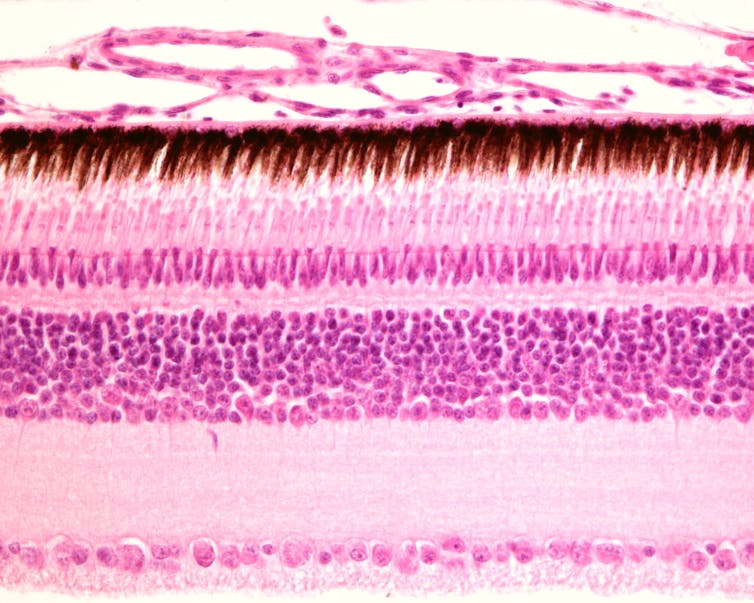Source: The Conversation (Au and NZ) – By Hessom Razavi, Associate professor, The University of Western Australia
A solar eclipse will occur across the whole of Australia on Thursday morning. It will be most visible in the Ningaloo region of Western Australia. Thousands of people will visit the small coastal town of Exmouth to witness this spectacular event, while Australians elsewhere will experience a partial eclipse.
It is imperative to take steps to protect your eyes from solar retinopathy – permanent eye damage caused by looking at directly at the sun. Expert guidelines advise people to never look at the sun or an eclipse with the naked eye. Any direct viewing should only be done with the correct use of approved solar eclipse glasses that meet an international safety standard known as ISO 12312-2.
Also known as sun blindness, solar retinopathy has been recognised since Ancient Greece. It affected astronomers including Sir Isaac Newton, who once used a mirror to look at the sun and saw “afterimages for months”.
Looking too closely
In Türkiye in 1976, 58 patients sought treatment for eye damage after an eclipse. While some experienced initial improvements, the damage in others was unchanged 15 years later.
In 1999, 45 people presented to the Eye Casualty of Leicester Royal Infirmary after an eclipse seen there. Retinopathy was confirmed in 40 of them. Seven months later, four people could still see “the ghosts of the damage” in their visual field.And after the solar eclipse of August 2017, 27 patients in the American state of Utah presented with concerns about vision.
For those people affected by solar retinopathy, the results can be devastating and lifelong.

Shutterstock
Read more:
Humans have been predicting eclipses for thousands of years, but it’s harder than you might think
What happens to your eye when you stare at the sun?
Solar retinopathy is damage to the back of the eye (the fovea centralis in the retina) from exposure to intense light. It is typically caused by sungazing or eclipse viewing but can also result from welding without a shield, looking at laser pointers and from some surgical and photographic lighting.
A process called “phototoxicity” happens when the energy in the light forms damaging free radicals and reacts with oxygen within the retina. This disrupts the retinal pigment epithelium (a layer of supportive cells beneath the retina) as well as the choriocapillaris (blood vessels) beneath.
Fragmentation of the photoreceptors, nerve cells within the retina that detect light and colour, follows and can result in permanent loss of central vision.
Some wavelengths of light that cause solar retinopathy – such as Ultraviolet-A radiation and near infrared wavelengths – are not visible to humans, yet cause solar retinopathy in as little as a few seconds. This exposure doesn’t necessarily hurt at the time.
So eclipse gazing – even with little or no visible light and viewed briefly without pain – can lead to loss of vision.
There is no effective treatment
There is no proven treatment for solar retinopathy. Steroid medications have been tried without evidence of success, and may make things worse in some patients. Antioxidant medications are used in some eye diseases, but there are no studies showing a benefit in solar retinopathy. Vision may improve over time without treatment but many patients are left with residual deficits.
The mainstay of management is therefore prevention.
Read more:
A ‘hybrid’ solar eclipse is about to be visible in Australia. Here’s when and where you can see it
How to spot proper eclipse specs. 5 tips:
Only approved glasses will absorb the appropriate wavelengths of visible, ultraviolet and infrared light. They must:
- be purchased from reputable vendors to ensure they are not counterfeits
- display the correct safety certification (ISO 12312-2)
- not be scratched, cracked or show any other signs of damage
- fit your face properly so no gaps let light in (check they fit over your usual glasses if you need these to see normally)
- be checked by looking at a lamp or light bulb – only light from the sun should be visible through genuine eclipse glasses. This check doesn’t risk eye damage provided the previous steps have been followed.
In Exmouth in WA, the Chamber of Commerce and Industry has purchased some 20,000 eclipse viewing glasses, which meet the international ISO safety standard.
Regular sunglasses, polaroid filters, welding shields, X-ray film, neutral density filters, red glass filters, mobile phones and homemade sun filters are not safe for viewing the sun or an eclipse.
What if you think the damage is done?
Symptoms to watch out for include blurred vision in one or both eyes within one to two days of exposure.
People may also experience blind spots, altered colour vision, visual distortion (straight lines appearing kinked or wavy), micropsia (objects appearing smaller than normal), light sensitivity and headache. There may be no symptoms at all in the first few hours to a day.
If you have symptoms, abstain from further eclipse viewing. Use dark sunglasses and painkillers (such as paracetamol) for light sensitivity and headaches. Arrange an urgent appointment with an ophthalmologist (or an optometrist, GP or emergency department, who may then refer you to a specialist).
Read more:
Explainer: what is a solar eclipse?
What about totality though?
A total solar eclipse may potentially be viewed without eye protection, but only during the brief period while the moon completely covers the sun (the period of totality).
This will only occur over the Ningaloo region of Western Australia, including Exmouth, just before 11.30am (AWST) and last between 54 and 58 seconds, depending on exact location. The Astronomical Society of Australia has an interactive map which eclipse viewers should visit, to determine the precise timing of totality in their location.
But this still has risks. Eclipse glasses should only be removed after totality has commenced, when the moon has completely covered the sun and it suddenly becomes dark. Just prior to the sun reappearing, eclipse glasses must be replaced, to keep observing the remaining partial eclipse.
Remember, totality will only occur over the Ningaloo region, so it not safe to view the eclipse without protection anywhere else in Australia.
A solar eclipse is a rare occurrence. People will naturally be curious to observe it. Following the right advice will mean they can do it safely.
![]()
Hessom Razavi does not work for, consult, own shares in or receive funding from any company or organisation that would benefit from this article, and has disclosed no relevant affiliations beyond their academic appointment.
– ref. Turn around, bright eyes. Here’s how to see the eclipse and protect your vision – https://theconversation.com/turn-around-bright-eyes-heres-how-to-see-the-eclipse-and-protect-your-vision-203571







